Why you can trust Tom's Hardware
Our standard benchmarks and power tests are performed using the CPU’s stock frequencies (including any default boost/turbo), with all power-saving features enabled. We set optimized defaults in the BIOS and the memory by enabling the XMP profile. The Windows power scheme is set to Balanced (default) for this baseline testing, so the PC idles appropriately. To get the most out of the Intel Alder Lake chips, you need to be on Windows 11 with its updated scheduler. In most cases, Windows 10 performs well. However, some tests (Cinebench R20, Corona and POVRay) take a significant hit. In short, if you’re going with Alder Lake, you must upgrade to Windows 11 for the best results across the board. That may change with patching and updates. We’ll keep you posted.
Synthetic Benchmarks
Synthetics are a great tool to determine how a board runs, as identical settings should produce similar performance results. Turbo boost wattage and advanced memory timings are places where motherboard makers can still optimize for either stability or performance, though, and those settings can impact some testing.



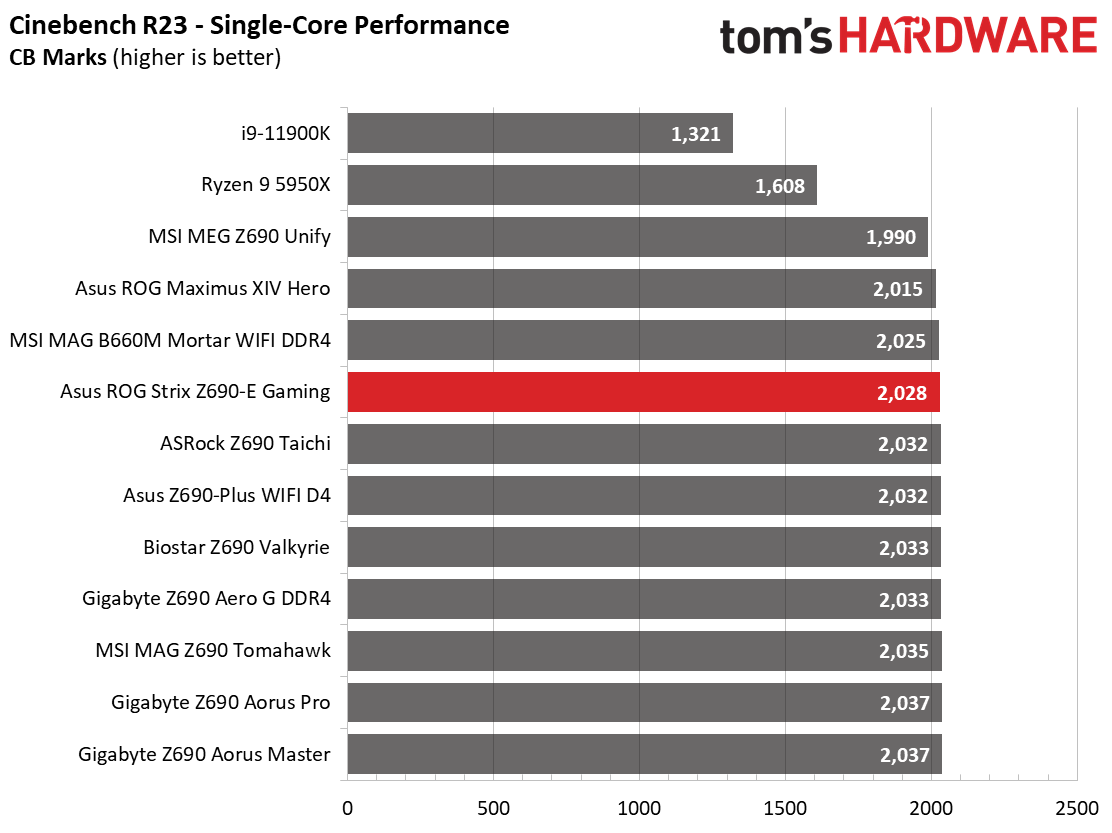
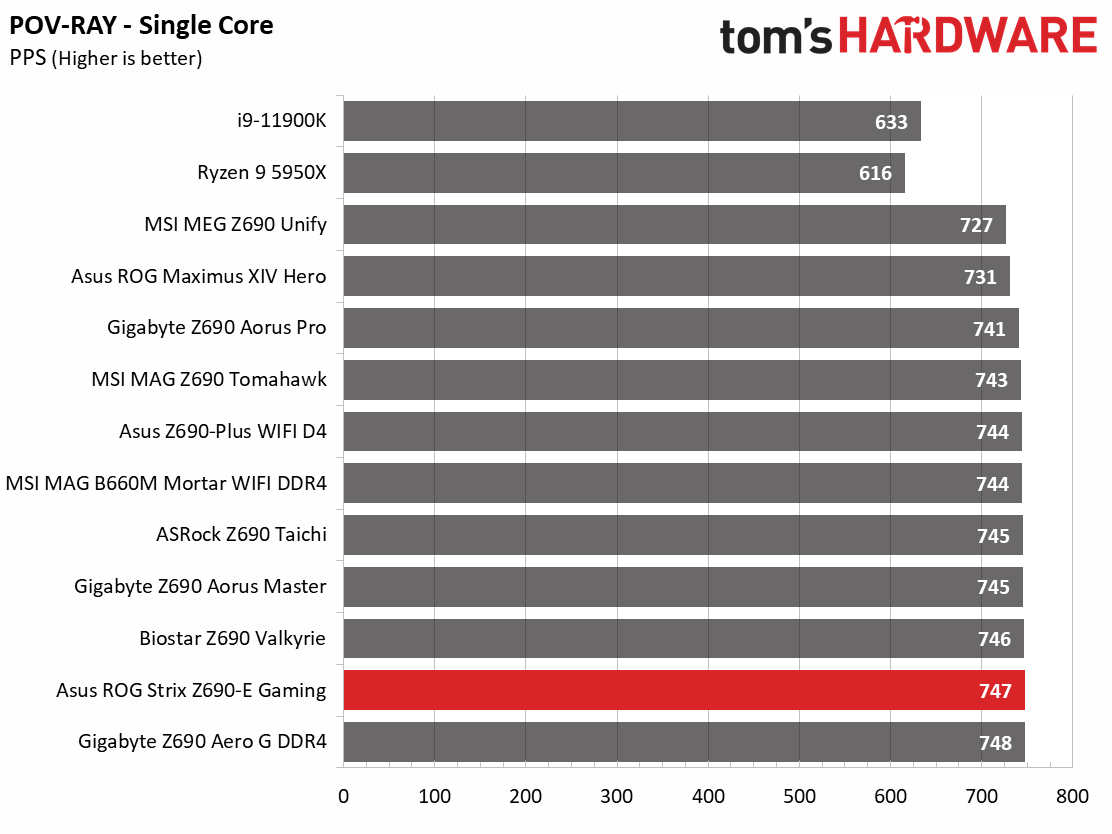

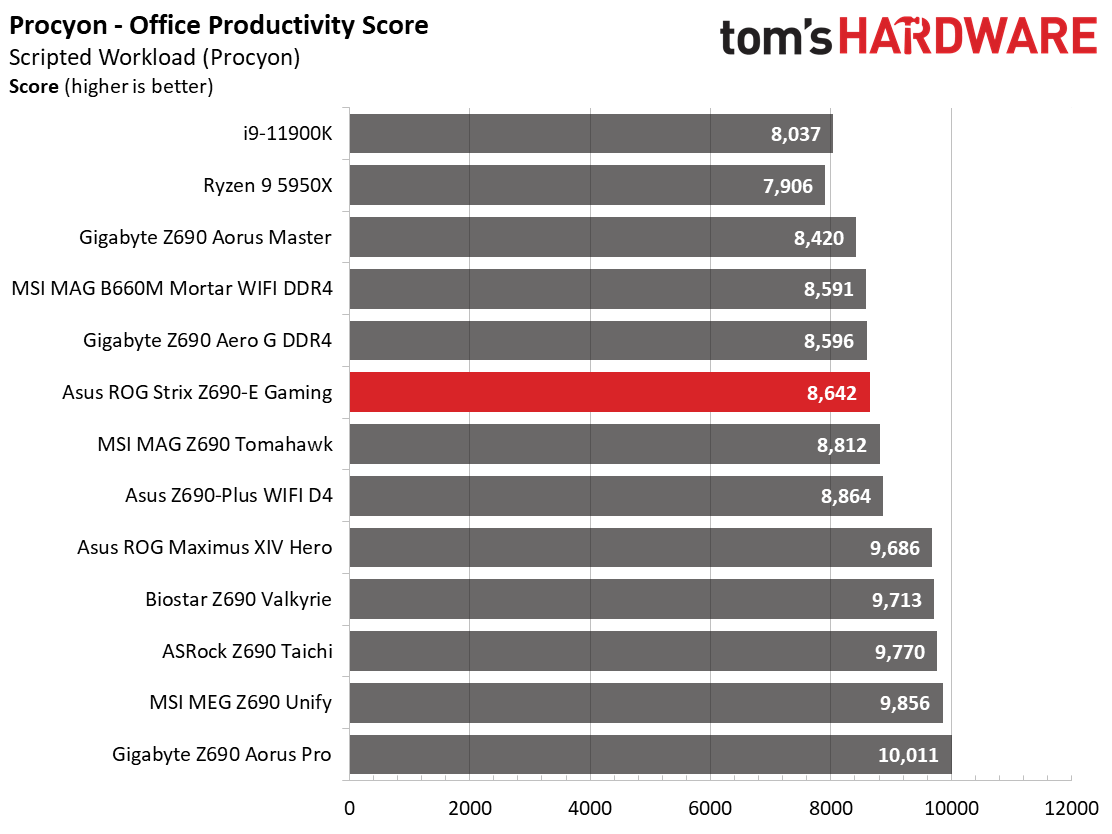









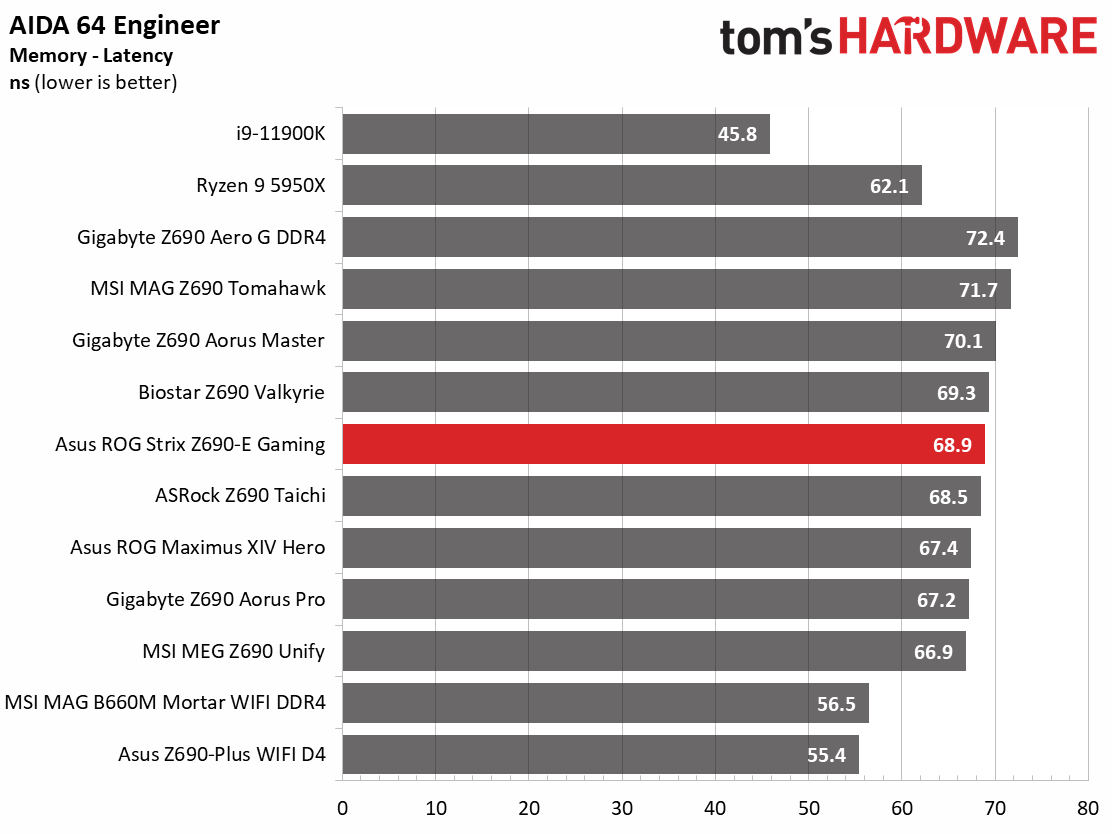
In our synthetic benchmarks, the Z690-E Gaming was average or slightly below most of the boards tested so far. These tests compared more closely to the DDR4 systems, which end up a few percent slower than the DDR5 systems. AIDA64 memory bandwidth results were above average outside of latency, where it was in the middle.
Timed Applications




Starting with the LAME timed test, the Z690-E Gaming posted one of the fastest results at 9.56 seconds (fastest is 9.50 seconds). Corona testing was average, with the Aorus Master completing the test in 52 seconds and mixing with the DDR4 and DDR5 results. Moving on to Handbrake, the x264 test completed in 116 seconds, matching the DDR4 boards and a second or two slower than the rest. The x265 result of 306 seconds was the slowest so far. That said, the majority are only a couple of seconds faster so the difference isn’t that significant. The difference between the fastest and slowest in this test is 12 seconds or around 4%.
3D Games and 3DMark

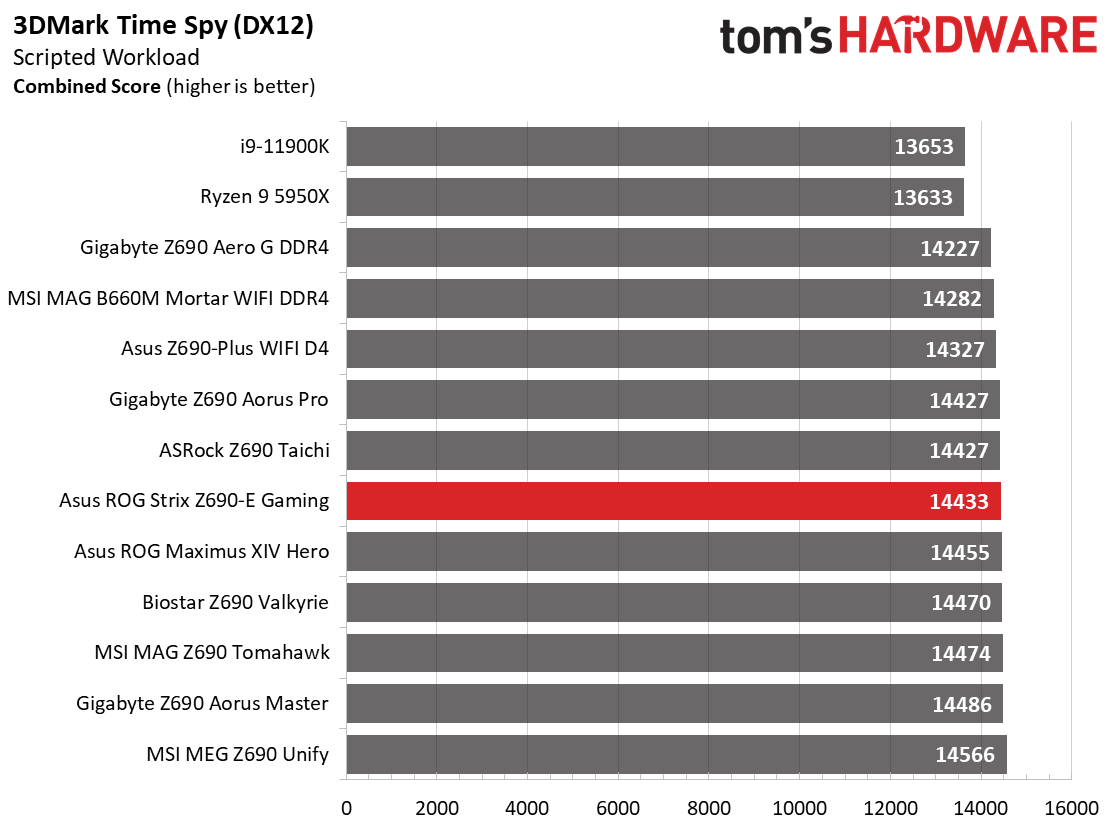
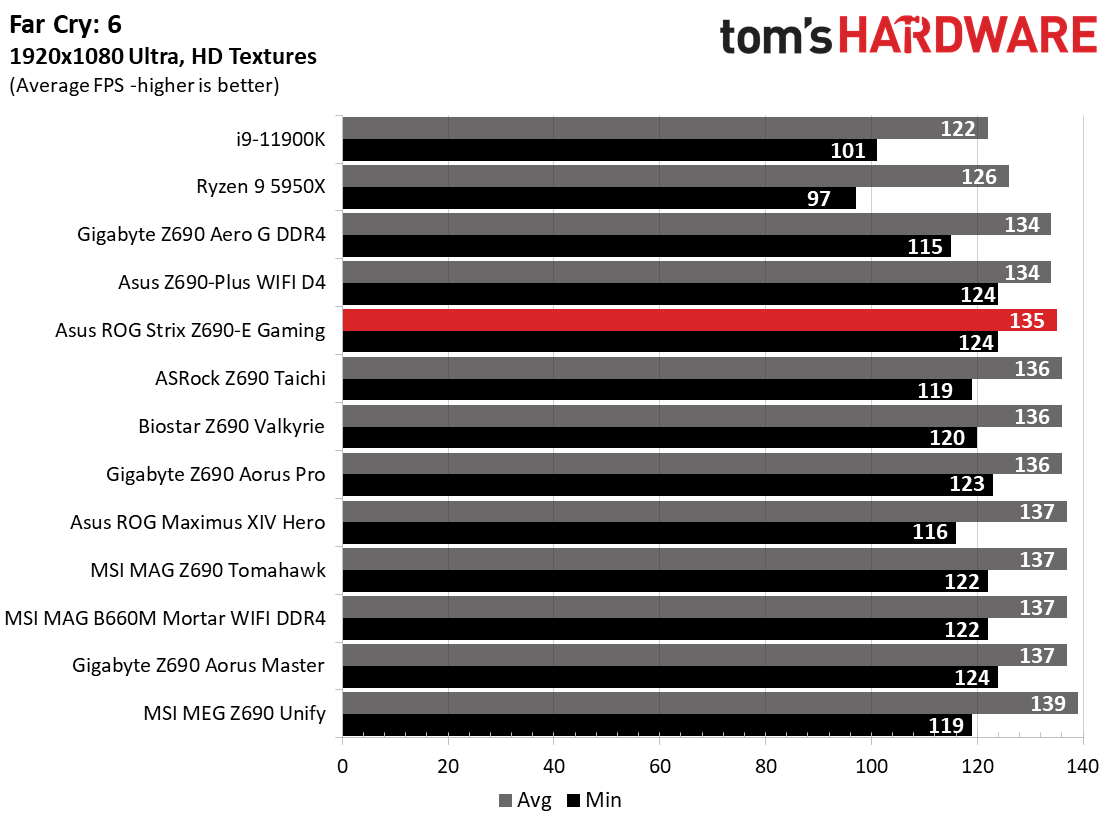

Starting with the launch of the Z690 chipset, we’ve updated our game tests. We’ve updated Far Cry: New Dawn to Far Cry 6 and shifted from F1 2020 to F1 2021. We run the games at 1920x1080 resolution using the Ultra preset (details listed above). As the resolution goes up, the CPU tends to have less impact. The goal with these settings is to determine if there are differences in performance at the most commonly used resolution with settings most people use or at least strive for. We expect the difference between boards in these tests to be minor, with most falling within the margin of error differences. We’ve also added a minimum fps value, as that can significantly impact your gameplay and immersion experience.
In F1 2021, the Z690-E Gaming averaged 164 Frames Per Second (fps), with minimums of 140 fps, which is right around our current average. Far Cry 6 averaged 135 fps, with minimums of 124 fps. The minimum matches the highest results, but most are only a couple of fps behind.
3DMark Time Spy scored 14,433 (one of the highest results so far), while in Fire Strike Extreme, the 16,820 is a bit below average. Again, even with DDR4, the difference between motherboards in these 3DMark benchmarks is negligible.
Get Tom's Hardware's best news and in-depth reviews, straight to your inbox.
Power Consumption / VRM Temperatures
We used AIDA64’s System Stability Test with Stress CPU, FPU and Cache enabled for power testing, using the peak power consumption value. The wattage reading is from the wall via a Kill-A-Watt meter to capture the entire PC minus the monitor. The only variable that changes is the motherboard; all other parts are the same.
At idle, the Z690-E Gaming used 57W, which is around the average of DDR5 boards. Load wattage peaked at 300W, around the average for our Z690 motherboards. Overall, this board is average when compared against the DDR5 motherboards we’ve tested using an Alder Lake-based processor. The Z690-E reaches the same 4.9/3.7 GHz all-core clocks at stock as most others, so we’re all set there.




VRM temperatures on our probes peaked around 52 degrees Celsius during stock testing and reached 48 degrees Celsius when overclocked. At stock settings with all voltages on auto, this board uses more power than what we need for our overclock. These temperatures were well within the operating spec of the VRMs and aren’t out of line compared to other boards. The oversized heatsinks do an excellent job keeping the VRMs running cool.
Overclocking
Overclocking with Alder Lake is slightly different from what we’re used to due to the hybrid core configuration. Now, you can overclock the P and E cores separately, though they both use the same voltage domain. You can push one and not the other, or both, so there’s some flexibility. To that end, we set an overclock to 5.1 GHz across all P-cores and 4.1Ghz on all E-cores. This yields a 200 MHz bump on the P-cores and a 400 MHz increase on the E-cores. We’re topped out on the P-cores, primarily due to temperatures, but the more efficient E-cores still have some headroom.
Overclocking with the Z690-E Gaming with our flagship 8+8-core/24-thread i9-12900K proved painless again. Since we’ve found our required voltage with the first board we used, we plugged in that 1.25V value for Vcore, and off we went testing. There was a fair amount of vdroop when using Asus’ recommended LLC4 setting, but changing that to LLC6 brought things back in line, minimizing any voltage drop.
The 90A VRMs held their own, easily handling the ~210W HWinfo says the processor is using. As we mentioned previously, the only limits in overclocking you have on this board would be keeping the processor cool.
Final Thoughts
After our time with the Asus ROG Strix Z690-E Gaming WIFI ($469.99), we like what the board has to offer overall. From the rare integrated PCIe 5.0 M.2 socket and the heatpipe cooling and premium audio solution to the 12 USB ports out back, it’s got almost anything a user is likely to want from a motherboard–or at least a gaming-focused board. Asus gave the updated model an improved look, more robust power delivery, and a higher M.2 count over Z590, along with a significantly higher price point, which unfortunately is basically par for the course.
On the performance front, the Z690-E Gaming was for the most part comparable to the DDR4 boards we’ve tested previously. In other words, in some tests, particularly heavily multi-threaded tests, the board holds back performance just a bit compared to the other DDR5 boards, as it follows the Intel specification more closely than others. But, switch on the Asus Enhancement feature (an option in the BIOS), and it then performs just as well as similarly priced competition. Regardless, the difference in most tests are difficult to notice unless you’re benchmarking. Gaming performance was spot on, so we’re set there.
Competition is fierce at this price point. Gigabyte has the Z690 Aorus Master ($469.99), MSI the MEG Z690 Unify ($489.99), and ASRock has its PG Velocita ($469.99 MSRP). If you want/need five M.2 slots, the Gigabyte, Asus, and MSI have you covered, but only the Asus and ASRock offer PCIe 5.0 M.2 storage. If you’re looking for the latest audio codec, the Asus and MSI boards are the only options out of this group, with the former sporting a Savitech amplifier. All boards have capable power delivery, but the PG Velocita is by far the weakest of the bunch with 60A MOSFETs compared to 90A and 105A on the other boards. In the end, all of these boards are plenty capable. At the same or similar pricing, it’s a toss-up and comes down to wants, needs, and looks as to which to choose. But if you need a lot of USB ports, the ROG Strix Z690-E Gaming wins hands down.
MORE: Best Motherboards
MORE: How To Choose A Motherboard
MORE: All Motherboard Content

Joe Shields is a staff writer at Tom’s Hardware. He reviews motherboards and PC components.

